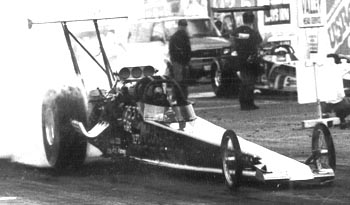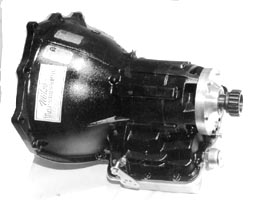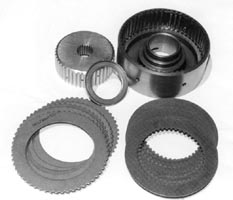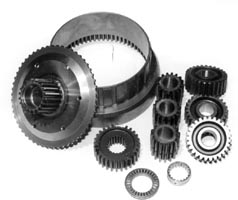|
|
|
|
 |
||

Mike's Top Dragster is the test bed for the Monster Glide. It runs consistent 6.50's at 210+ and after 55 passes the Monster Glide has required zero maintenance. |
||
|
In today's drag racing it is not unusual to find 2000hp engines in all types of race cars. From NMCA Pro Streeters to IHRA Top Sportsman and Top Dragsters, engines that develop 2000hp and almost as much torque have become commonplace. Many of these cars are equipped with some modified version of the venerable GM two speed 'glide, and in some classes it is required. Unfortunately, it is not unusual to see these cars, which can weigh anywhere from 1700lbs to 2700lbs, trail a stream of trans fluid when the afore- mentioned 'glide spilled its innards all over the track after trying to transmit 2000hp or more than 1500 ft lbs of torque to the pavement. Because of that, many racers are forced to use the heavy but reliable planetary transmission and clutch combination. While that combination is easily capable of handling the power, it much heavier and requires more maintenance than the glide. Additionally, the racer ends up with a heavier car and in some sanctioning bodies he gets an additional weight penalty for using the planetary transmission. What racers wanted was a lightweight powerglide that could take the abuse of a 2000hp engine in a heavy doorslammer and live. "No way!" you say. "Yes way!" says Mike Stewart of Mike's Transmission in Lancaster, California. Mike has been building 'glides for high horsepower engines for over ten years. In fact, as far back as 1986 he had 'glides in Frank and Lena Williams' NHRA legal alky funny car that went deep in the sixes at over 200mph. Then NHRA, probably with the backing of the aftermarket tranny builders, decided that the 'glide wouldn't hold together in those cars and banned OEM transmissions from use in Top Alcohol Dragsters and Funny Cars. Mike then applied what he had learned with the blown alcohol car to design and build 'glides for use behind big horsepower supercharged and nitrous oxide-injected engines in 3000lb street cars. His transmissions are so reliable that engine builder Jim Oddy recommends Mike's transmissions to all of his engine customers who want to run an automatic trans. Despite his success with transmissions built using stock cases, Mike knew that it was just a matter of time before the racers would start building race cars with engines powerful enough to need something stronger than a stock case tranny. That is when he started developing his current state-of-the-art 'glide using an aftermarket case and custom fabricated parts. He calls it his "Monster Glide."
The most important part of the combination is Mike's custom-built input shaft. It is 1.060 in diameter, which is .100 larger than any other shaft currently available. Even at its narrowest point Mike's shaft is .125 bigger than a standard shaft. "This shaft is designed to take up to 1970 ft lbs of torque, and is 30 to 40 percent stronger than any other shaft we have used, " Mike said. "We developed this shaft to live under what we call the slam factor." The slam factor is what happens to an input shaft when rear tires start to hop off of the track at full throttle. When they come off the ground the tires spin and when they slam back down on the track the input shaft is subjected to a lot of instant torque which causes shaft failure.
Every component in the Monster Glide is designed to reduce friction, reduce weight (both rotating and static), and increase durability. The transmission was developed by Mike to make this the strongest, most reliable powerglide transmission on the market. Since the transmission is designed to be used under severe conditions, it features pieces designed specifically to survive abuse. The pump and drum have been modified to move more fluid and improve cooling and lubrication. In addition, it has forged steel gears. Mike used to scour the salvage yards looking for 64-66 year model glides which had steel gears from the factory, but for the Monster Glide he had forged steel gears made. A modified direct drum holds nine clutches.
Monster Glide has billet parts installed wherever Mike
saw a weak spot. The carrier is billet with large straight cut gears,
which resist breaking, in either a 1.66 or 1.74 low gear ratio. A Kevlar
low gear band helps performance. To help cut friction the output housing has roller bearings and a roller thrust bearing is also used. Finally, a lightweight aluminum valve body is used which is nine pounds lighter than a stock unit. When the entire unit is bolted together, serviced with synthetic fluid and ready to race it weighs in under 90lbs. Just to make sure that the transmission worked as he wanted it to, Mike put one in West Coast racer Rudy Resch's turbocharged small block 'Vette. The Vette's turbo-motor makes 1800hp on the dyno. The 2500lb car runs 7.30's at 190+, but constantly broke the 'glides that were in the car until Rudy installed a Monster Glide as a last resort. Now the car has made over 100 laps without even doing maintenance. The Monster Glide isn't cheap. It costs $4995.00 and that doesn't include a converter, but if a lightweight two speed trans is what you need and you've got gobs of power under hood then the Monster Glide might just be what you need. It's alive! It's alive!
photos by Tim Marshall
|
||
|
Copyright 1999, Drag Racing Online and Racing Net Source |
||
 When
Mike's builds a Monster Glide he starts with a Dedenbear aftermarket
powerglide case. The Dedenbear case comes with an SFI approved liner
so no shield is required. Then Mike begins filling the case with the
custom built components he has developed for the Monster Glide.
When
Mike's builds a Monster Glide he starts with a Dedenbear aftermarket
powerglide case. The Dedenbear case comes with an SFI approved liner
so no shield is required. Then Mike begins filling the case with the
custom built components he has developed for the Monster Glide.  Mike's shaft has the
turbo splines that most racers prefer.
Mike's shaft has the
turbo splines that most racers prefer.  "We've
given the racer 30 percent more clutch surface area using nine discs
which means more time between clutch replacement and better dependability,"
Mike explained. The clutch hub itself is wider than stock and has the
stator tube bored out .125 to accept the larger shaft.
"We've
given the racer 30 percent more clutch surface area using nine discs
which means more time between clutch replacement and better dependability,"
Mike explained. The clutch hub itself is wider than stock and has the
stator tube bored out .125 to accept the larger shaft.  A billet dual O-ring servo is used which seals better
and helps the line pressure remain high in low and high gear.
A billet dual O-ring servo is used which seals better
and helps the line pressure remain high in low and high gear.